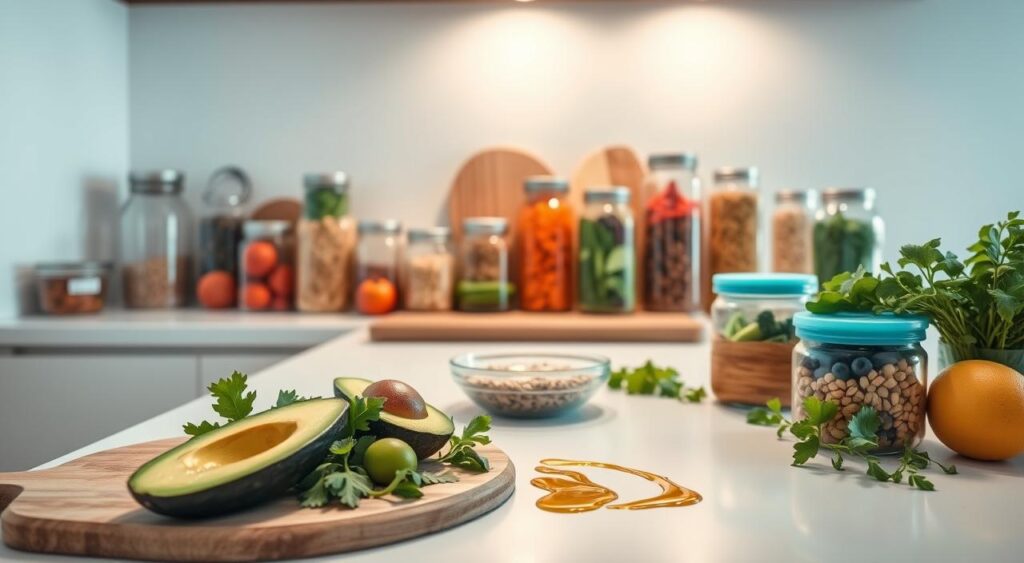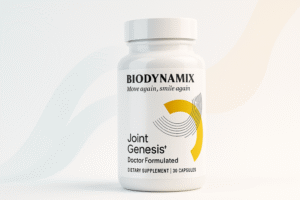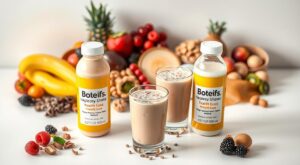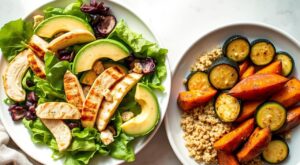Ever thought about how your meals affect your energy and work performance? As a busy pro, chronic inflammation might be slowing you down. It can cause joint pain, fatigue, and weight gain. But, using anti-inflammatory meal prep ideas can change that.
Adding anti-inflammatory foods to your diet saves time and boosts nutrition. This can greatly improve your health and well-being. We’ll share healthy eating tips and low sodium recipes to make meal prep easy and effective. Discover how simple changes in meal prep can boost your daily life!
Understanding Anti-inflammatory Foods
Eating anti-inflammatory foods can greatly improve your health. These include fruits, vegetables, whole grains, legumes, and fatty fish like salmon or walnuts. Adding these to your diet helps fight chronic inflammation and its health risks.
What are Anti-inflammatory Foods?
Anti-inflammatory foods reduce body inflammation. Examples include:
- Fruits like blueberries, strawberries, and oranges
- Leafy greens such as spinach and kale
- Whole grains like quinoa and brown rice
- Legumes like beans and lentils
- Omega-3 fatty acids from fish and nuts
These foods not only feed your body but also boost your mind and overall health. Eating this way can make your daily life better.
Benefits for Busy Professionals
Busy professionals can greatly benefit from an anti-inflammatory diet. It can improve your focus, reduce sick days, and boost energy.
- Improved focus and cognitive abilities
- Fewer sick days due to reduced inflammation and chronic diseases
- Higher energy levels throughout the day
Also, cutting down on sodium by choosing natural foods helps control blood pressure. This supports a healthy lifestyle. Knowing the benefits of these foods helps you easily add them to your busy schedule.
Key Ingredients for Meal Prep
Choosing the right ingredients for meal prep can greatly improve your dishes’ nutrition. Focus on spices, herbs, fruits, and vegetables that fight inflammation. These ingredients are perfect for a low sodium whole food diet plan for beginners. They add flavor and health benefits.
Spices and Herbs to Include
When preparing meals, consider adding these essential spices:
- Turmeric: Known for its anti-inflammatory properties, it can easily be added to rice, soups, and stews.
- Ginger: This spice enhances flavor while also reducing inflammation.
- Garlic: A versatile ingredient that not only boosts taste but also supports immune function.
- Cinnamon: Adds sweetness without sugar and helps regulate blood sugar levels.
Fruits and Vegetables Rich in Antioxidants
Boost your meals with antioxidant-rich produce:
- Berries: Blueberries, strawberries, and raspberries are excellent choices for snacks or breakfast.
- Oranges: A refreshing fruit, perfect for adding to salads or enjoying alone.
- Leafy Greens: Spinach and kale provide essential vitamins and minerals.
- Carrots: Crunchy and sweet, they make a great addition to salads and stir-fries.
- Beets: These vibrant veggies elevate any dish with their unique flavor and health benefits.
Quick and Easy Meal Prep Tips
Busy professionals can change their food game with quick and easy meal prep. Learning the right techniques makes your meal prep journey fun and easy. Key parts include batch cooking and using your freezer well. These methods save time and help you stick to healthy eating.
Batch Cooking Basics
Batch cooking lets you make many meals at once, saving a lot of time. It’s perfect for those with tight schedules who want to eat well. Pick recipes that use similar ingredients to make shopping and prep simpler. Cook big batches, portion them out, and store in the fridge or freezer.
Here are some tips for batch cooking:
- Plan your meals ahead to avoid last-minute stress.
- Choose versatile ingredients like quinoa, beans, and veggies.
- Use different spices to add variety without extra work.
Using Your Freezer Efficiently
Your freezer is a key tool for meal prep. Properly storing prepped foods keeps them fresh longer and lets you enjoy different meals all week. Here are some tips for freezing food:
- Label each container with the name and date to avoid waste.
- Use containers or bags safe for the freezer to keep food quality.
- Freeze in portions for easy grab-and-go meals.
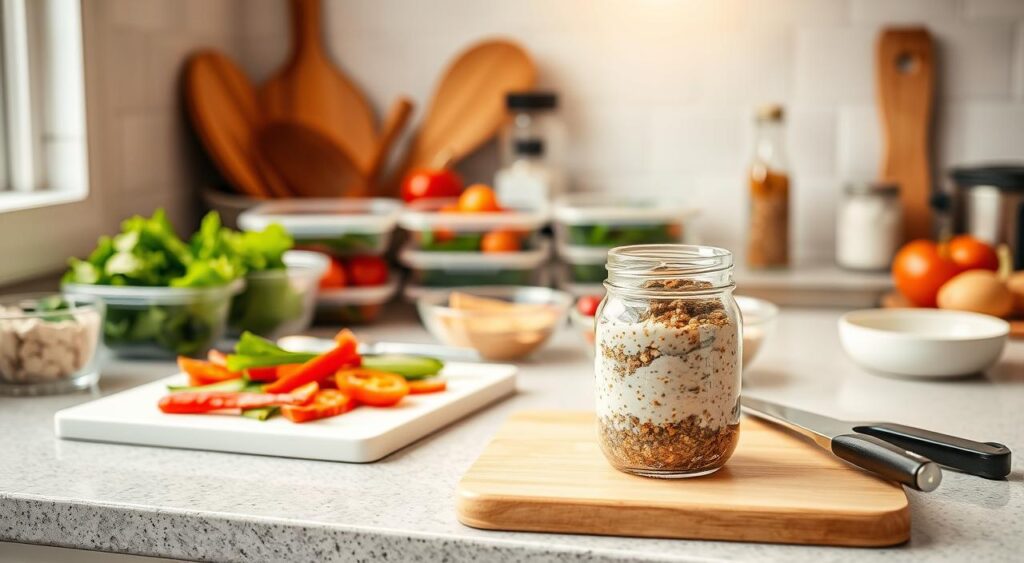
Breakfast Ideas for Busy Mornings
Starting your day with healthy breakfasts is key for energy and focus. Quick and tasty options help you avoid morning stress. They also fit a low salt diet.
Overnight Oats with Anti-inflammatory Ingredients
Overnight oats are a great choice for a tasty and nutritious breakfast. Mix rolled oats with almond milk, chia seeds, and a bit of honey. Add anti-inflammatory ingredients like:
- Blueberries
- Walnuts
- Ground flaxseeds
This mix is packed with nutrients and fits well with anti-inflammatory meal prep. Make several jars ahead of time for easy grab-and-go breakfasts all week.
Smoothie Recipes Packed with Nutrients
Blending smoothies is another smart way to begin your day. Blend spinach, a banana, and almond milk or low-sugar yogurt for a smooth texture. Boost the anti-inflammatory effects by adding:
- Frozen berries
- Nut butter
- Ginger or turmeric
These ingredients make a refreshing and filling breakfast that fights inflammation. Try different flavors and ingredients to find your perfect smoothie!
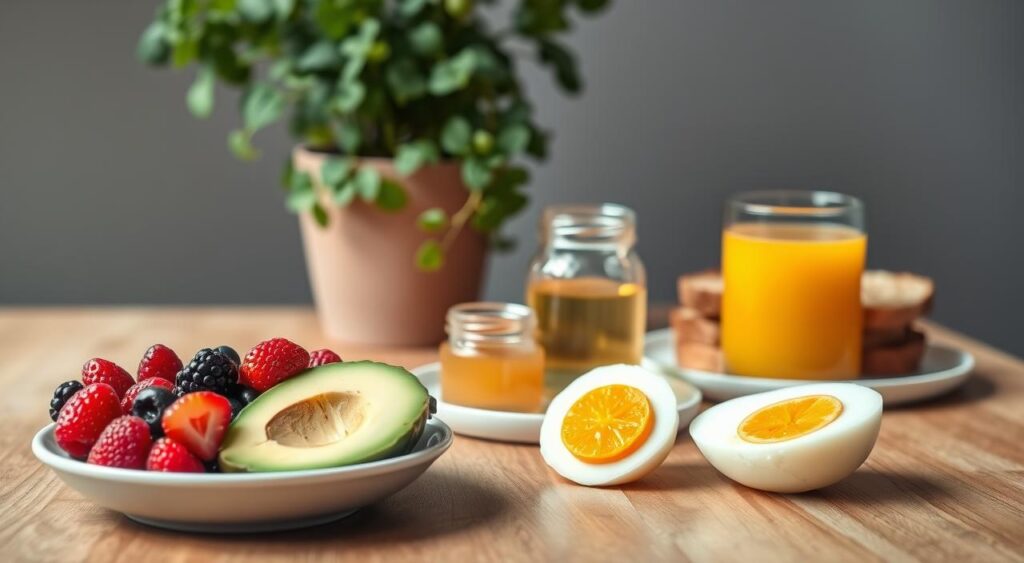
Lunch Options to Fuel Your Day
Keeping your energy up during the day is key. The right lunch can make a big difference. Try adding hearty salads and grain bowls to your meals. They’re not only tasty but also good for your heart and packed with nutrients.
Salads That Stay Fresh
Salads can be both filling and delicious. Mix quinoa, chickpeas, and greens for a healthy start. Add bell peppers and carrots for extra crunch. A light vinaigrette dressing made from olive oil and vinegar adds flavor without too much salt.
These ingredients will keep you going all day. For more ideas, check out some tasty low sodium recipes that also boost muscle health.
Grain Bowls for Versatile Meals
Grain bowls are a fun way to mix different flavors and toppings. Start with brown rice or farro, then add roasted veggies, beans, or lean proteins. Try adding avocado, nuts, or seeds for extra healthy fats.
This method is great for healthy eating tips. You can change up the toppings to fit your diet and taste. It keeps your meals interesting all week long.
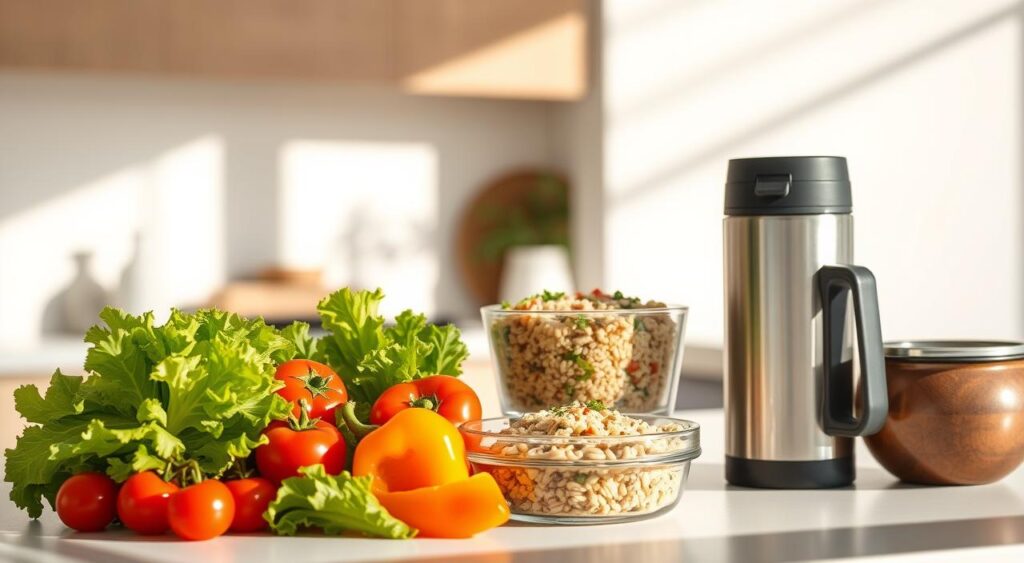
Dinner Recipes that Work
After a long day, you don’t want to spend hours cooking dinner. Anti-inflammatory meal prep ideas for busy professionals can help. Sheet pan meals and one-pot wonders are great because they’re easy to make and clean up. They also follow a clean eating guide, making them healthy and good for you.
Sheet Pan Meals for Simple Cleanup
Sheet pan meals are quick and easy. You can roast proteins and veggies together in one pan. Here’s a simple recipe to try:
- Ingredients: Salmon, Brussels sprouts, sweet potatoes, olive oil, garlic, and herbs.
- Preparation: Preheat the oven to 400°F. Toss Brussels sprouts and sweet potatoes with olive oil and garlic. Add salmon and herbs on top. Bake for 20-25 minutes.
This meal is full of omega-3s and antioxidants. It’s a great choice for anti-inflammatory meal prep.
One-Pot Wonders for Easy Cooking
One-pot meals are also great because they’re easy to make and clean up. They let you add many healthy ingredients. Try this quinoa and vegetable dish:
- Ingredients: Quinoa, diced tomatoes, black beans, corn, bell peppers, and spices.
- Preparation: In a big pot, mix all ingredients with water or broth. Boil, then simmer for 15-20 minutes, until quinoa is fluffy.
This dish is packed with nutrients. It follows a clean eating guide, helping fight inflammation and fit your busy life.
| Benefit | Sheet Pan Meals | One-Pot Meals |
|---|---|---|
| Cooking Time | 20-30 minutes | 15-20 minutes |
| Cleanup | Minimal | Minimal |
| Health Benefits | Rich in omega-3s, antioxidants | High in fiber, protein |

Snacks That Fight Inflammation
Snacking smartly can make a big difference in your day. It helps keep you focused and reduces inflammation. Here are some tasty options that are good for you and don’t have too much sodium.
Nut and Seed Mixes
Making your own nut and seed mixes is a great idea. They are full of healthy fats and protein. Choose almonds, walnuts, pumpkin seeds, and sunflower seeds for a boost of energy and less inflammation. Adding spices like turmeric or cinnamon makes them taste better and helps fight inflammation.
These snacks are perfect for when you need a quick energy boost. They don’t have too much sodium.
Veggie Dips with a Twist
Veggie dips can make snacking fun. Try hummus or yogurt-based dips with fresh veggies. Crunchy carrots, bell peppers, and celery are great choices. They satisfy your hunger and give you important nutrients.
Adding herbs like dill or garlic makes them taste even better. For more ideas, try using roasted red peppers or avocados in your dips. They add creaminess without unhealthy ingredients. This way, you can enjoy tasty snacks that are low in sodium.
| Snack Type | Main Ingredients | Benefits |
|---|---|---|
| Nut and Seed Mix | Almonds, Walnuts, Pumpkin Seeds | High in protein, low in sodium |
| Veggie Dips | Hummus, Yogurt, Fresh Veggies | Rich in nutrients, reduces inflammation |
Adding snacks like these to your diet is good for your health. They satisfy your hunger between meals. Enjoy trying new flavors and keeping your diet healthy and anti-inflammatory, even when you’re busy!
Meal Prep Tools You Need
Having the right tools can make a big difference in your meal prep journey. Investing in essential kitchen gadgets makes cooking easier and helps you stay organized. This lets you focus on making healthy meals. With the right storage, your dishes stay fresh, making prep work more efficient.
Below, we’ll look at some must-have gadgets for your kitchen.
Essential Kitchen Gadgets
- Food Processor: This versatile tool simplifies chopping, slicing, and mixing ingredients.
- Slow Cooker: Perfect for preparing large meals with minimal effort, letting you set it and forget it.
- Instant Pot: Combines several cooking functions, enabling quick and easy meal preparation.
- High-Quality Knives: A good set of knives is essential for efficient chopping and cutting.
- Measuring Cups and Spoons: Accurate measurements can improve the quality of your dishes.
Storage Solutions for Optimal Freshness
Effective storage is key to keeping your meal prep fresh. Consider these options:
- Glass Containers: Durable and microwave-safe, glass containers help you see what’s inside while keeping meals fresh.
- Freezer Bags: Ideal for bulk freezing soups, stews, and pre-chopped ingredients.
- Vacuum Sealers: Great for removing air from storage bags, helping prevent freezer burn.
- Labeling System: Use labels to mark dates on your meals for better organization and to avoid waste.
Planning Your Weekly Menu
Planning your meals helps you stay organized and meets your anti-inflammatory goals. A weekly menu makes your daily routine easier and ensures you eat a variety of healthy foods. This is key for busy people who want to follow beginner diet tips. Choosing the right ingredients for a low sodium whole food diet is important for fighting inflammation and keeping nutrition balanced.
Creating a Balanced Menu
When planning a balanced menu, think about these key points:
- Protein: Aim for at least 54 grams per day from sources like beans, legumes, and lean meats.
- Fruits and Vegetables: Choose anti-inflammatory options like berries, leafy greens, and apples.
- Healthy Fats: Add nuts and seeds for overall health.
- Whole Grains: Use whole grains to make your meals satisfying and nutritious.
Your menu could include a variety of dishes throughout the week:
| Day | Breakfast | Lunch | Dinner |
|---|---|---|---|
| Monday | Overnight oats | Quinoa salad | Sheet pan veggies |
| Tuesday | Smoothie bowl | Bean wrap | Lentil soup |
| Wednesday | Chia pudding | Grain bowl | Stir-fried tofu and broccoli |
Tips for Sticking to Your Plan
Staying on track with your menu can be tough. Here are some tips to help:
- Prep in Advance: Spend time on weekends for meal prep, like chopping veggies and cooking grains.
- Keep it Simple: Choose easy recipes to make meal prep easier.
- Stay Flexible: Swap ingredients or recipes as you like. A low sodium whole food diet plan for beginners lets you try new things.
For more ideas on adding anti-inflammatory foods, check out this meal plan. Being consistent and sticking to your plan will help you see lasting results.
Staying Motivated with Meal Prep
Maintaining motivation during meal prep can be tough. Starting a low salt meal plan might seem overwhelming. But, setting realistic goals and making meals fun can help you stay on track. Using the right strategies makes meal prep enjoyable and keeps you committed to healthy eating.
Setting Realistic Goals
When starting meal prep, it’s key to set achievable goals. Here are some tips:
- Decide on a specific number of meals to prep each week.
- Choose recipes that fit your skill level to avoid getting frustrated.
- Begin with cooking one or two meals, then add more as you get better.
Keeping it Fun and Engaging
Adding creativity to meal prep makes it fun. Here are some tips to make it more enjoyable:
- Try new ingredients and flavors to avoid the same old dishes.
- Get friends or family involved for a fun, social experience.
- Look for support in meal prep communities. Online forums are full of ideas and encouragement.
Remember, meal prep should fit your lifestyle. Keeping it fresh and fun supports your low salt meal plan. It also helps you stick to healthy eating habits.
Resources for Learning More
Learning more about anti-inflammatory meal prep can make cooking and meal planning better. Having the right resources helps you on your path to a healthier life. It brings new ideas and insights to your table.
Cookbooks Focused on Anti-inflammatory Diets
Cookbooks on anti-inflammatory diets are full of recipes and tips. Books like “The Anti-Inflammatory Diet & Action Plans” and “The Anti-Inflammatory Cookbook” are great for beginners. They offer tasty recipes and teach you about the benefits of anti-inflammatory foods.
Online Communities for Support
Online communities are great for those following an anti-inflammatory diet. Sites like Facebook groups or Reddit threads for healthy eating are perfect. They let you share your journey, ask questions, and find new meal prep ideas.
Connecting with others who have similar goals can boost your motivation. It makes meal prep more fun and rewarding.

